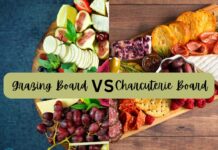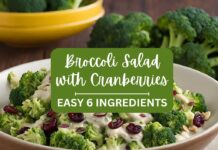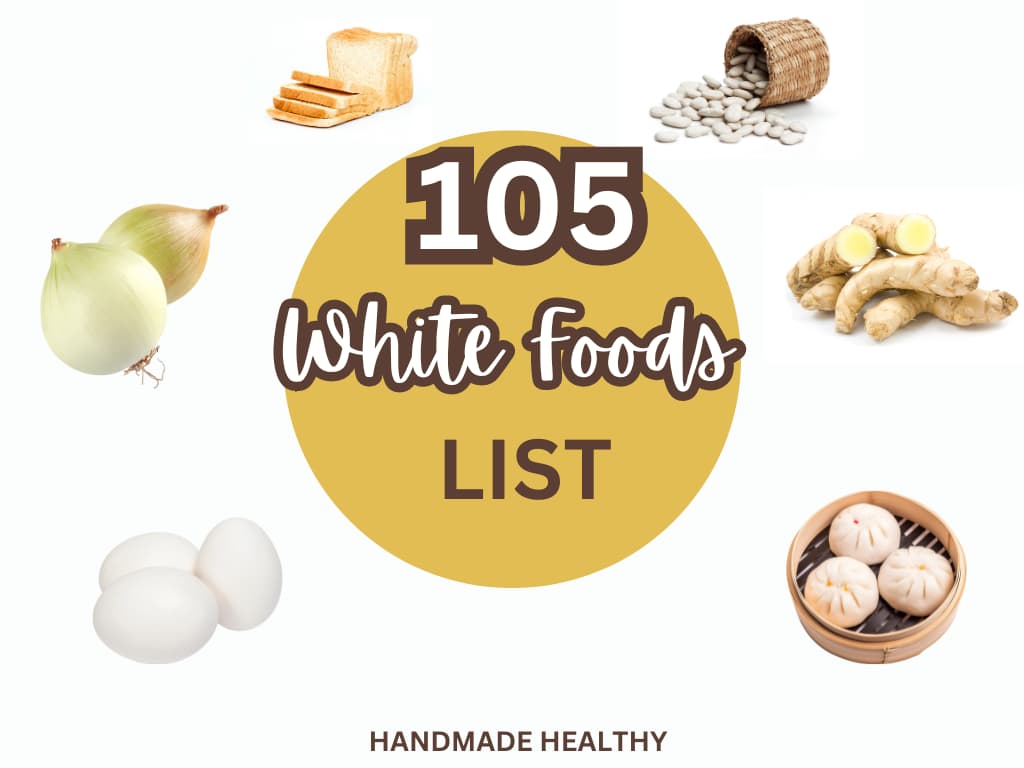You are looking for the white food list that everyone is talking about. This list of white foods makes it so easy to create your list of foods to meet your needs. Alternatively, if there are white foods that you are trying to avoid, check the list for some ideas.
A white food list is something that you may be looking for a number of reasons. Here we are listing the reasons why you might be looking for the white food list. We also uncover the variety of categories of white-colored foods. Finally, we will discover some recipes featuring nutritious white foods.
The majority of this white food list are items that you can actually find in the local grocery store (depending on where you live).
5 Reasons to Learn About White Food List
Looking for a white food list? Let’s talk about why you might be looking for a white food list. There are several reasons why you might be looking for a white food list including nutrition, food allergies, culinary uses, medical reasons, and cultural dishes. Let’s breakdown each of these reasons.

Nutrition
If you are looking to add a variety of colors to your diet, the white foods can also be an option for color. Different naturally colored foods that are white such as white fruit or vegetables contain different micro-nutrients.
Whether you are eating foods with white flesh or colorful foods, eating the right portions of a variety of foods is still important.
White Food Nutrition
When you think of white vegetables especially, they contain essential nutrients such as fiber, potassium, and magnesium. Additionally, many people do not consume enough vegetables let alone fiber each day. So these white food vegetables are great to put into the vegetable rotation. Not only that but there are also white vegetables and fruits that contain antioxidants.
In addition, another example of a white flesh nutritious produce items is the dragon fruit. Dragon fruit contains vitamin C, magnesium, and fiber as well.
Food Allergies
Allergies to food are very serious, so it is important to work with your health care provider if you suspect a food allergy. When considering food allergies, it is important to determine the cause of the allergic reaction. Therefore, if your health care provider tells you to think of white foods that you eat, the list on this page is a good starter. Although, the list does not name every white food, there are many that may help to give ideas in which to start.
Culinary Uses
Calling all chefs and cooks, white foods are commonly found in a many dishes that we eat including onions and garlic for a mild flavor. Therefore, culinary artists may be looking for a list of white foods to include in their dish for flavor. Additionally, the aesthetic appeal of the white food is also a useful way to use the white food list.
Medical Reasons
Are you looking to be on a white diet? Are you looking to avoid white food?
If you are looking to eat less white foods to help with glycemic index, blood sugar levels, or weight loss, it important to understand counting carbs. Not only that but looking at the types of carbohydrates, for example, white rice versus brown rice.
No Sugar No White Flour Food List
Having a list of no sugar no white flour food can help with choosing more foods with less added sugar and more complex carbohydrates. Choosing foods with more whole grains and fiber can help with blood sugar, however, portion sizes and variety of nutrients are also important to consider.
Cultural Dishes
There are plenty of ways to eat healthy ethnic and cultural dishes. Some of the white foods that are found in many cultural dishes include: steamed rice, spicy chicken, and soft corn tortillas. Additionally, root vegetable and coconut milk are also a part of cultural dishes. Not only do these add so much flavor but also lend themselves to a variety of culinary uses.
Are White Foods Nutritious?
White foods specifically fruit and vegetables are considered nutritious based on PubMed Executive Summary. White foods including potatoes can be sources of fiber, potassium, and magnesium. Not only that, but white vegetables such as potatoes can bridge the gap to help increase vegetable consumption as long as it is limited in salt and fat, aka fried potatoes.
Of course, there are many white foods that contain less nutrition that serve as more of a low fiber or added sugar item such as marshmallows for example.

Types of White Food List
There are many types of white foods. Each list of white foods is divided into its most fitting category to make it easier to find. White foods in general can range from nutritious fruits and vegetables to sugary treats like cake and marshmallows.
The list of white foods consist of the following categories. Jump to each category by clicking on the category name.
Healthy and Nutritious White Foods
You may be wondering “are there healthy white foods?’ Of course, there are healthy white foods. Namely, white vegetables are ideal for choosing a food higher in nutritional value. In addition, you might even find a staple food that is a white food that can also be part of a healthy diet.
Healthy and nutritious white foods are mainly made up of the fruit and vegetable category. However, there are additional items such as beans and lentils that are a source of protein and fiber. In addition, dairy products are sources of B12, protein, and essential nutrients that are also in the nutritious white foods category.
Here is a great list of white food items that are easy to add to your next grocery shopping list.
- Cauliflower
- Garlic
- White Onions
- Ginger
- Turnips
- Jicama
- Mushrooms
- White beans
- White lentils
- Tofu
- Quinoa (white variety)
- Greek yogurt (plain, unsweetened)
- Cottage cheese (low-fat or fat-free)
- White fish (e.g., cod, haddock, halibut)
- Skinless chicken breast
- Turkey breast
- Egg whites
- White cabbage
- White radish
- White mushrooms
- White turnips
- White lentils
- White kidney beans
- White quinoa
- White turkey meat (deli slices)
- Whitefish (e.g., tilapia, sole)
- White miso paste
- White sesame seeds
- White balsamic vinegar
- Garbanzo Beans
- Dairy Products
- White Tea
- Soy Milk
As you can see this category has a large variety of items that can be used in many culinary uses and flavors.
Snack White Foods
There are many snack food items with a white color. It’s not just limited to vanilla ice cream and white cheeses. There are definitely some great snack options to be nutritious choices, however, there are also some items that are to be consumed little to moderation. For example, air popped popcorn is a white snack food that has fiber, where as, white chocolate-covered pretzels may be more of a snack that is better in moderation.
Let’s go through some of the most popular white food snacks.
- Popcorn (plain, air-popped)
- Rice cakes (plain or lightly salted)
- Yogurt-covered pretzels
- White cheddar cheese
- White chocolate (in moderation)
- Coconut chips
- Banana chips
- Saltine crackers
- Rice crackers
- Vanilla-flavored protein bars
- White popcorn kernels
- Yogurt-covered almonds
- White chia seeds
- White rice crackers
- White cheese popcorn
- White chocolate-covered nuts
- White chocolate-covered pretzels
- sour cream
- breakfast cereals
- salad dressings
This snack white food category has a variety of items that are useful for snacks on the go. However, there are some snacks that are best consumed in moderation if they are higher in added sugar and saturated fat.

White Vegetables
What white vegetables can I add to my list? Whether you are making a white vegetable list to add more variety to your list, or if you are looking for some new culinary ideas, there are more items than you may think.
The first white vegetable that pops into my mind is cauliflower because it one of the most familiar white vegetables. However, there are several items that may have a colored skin but a white flesh inside such as potatoes, parsnips, and jicama.
What are the health benefits of white vegetables?
Whether the white is on the flesh of the vegetable or the outer layer, there are some health benefits of white vegetables. As mentioned, PubMed Executive Summary describes potatoes as a vegetable example to talk about the nutrient content for fiber, potassium, and magnesium.
Some of the items in this white vegetable list may be a seasonal find or special order such as white asparagus versus green asparagus or a white bell pepper versus a green bell pepper. Therefore if the white version of the item is not available, is its colored counter part able to be used for your dish?
Here is a great list to start to create your white vegetable list. Moreover, there are many ideas for this list of white vegetables that are perfect for adding to the shopping cart.
- White Potatoes (white variety)
- Parsnips
- Jerusalem artichokes
- Kohlrabi
- Daikon radish
- White asparagus
- White corn
- White bell peppers
- Fennel
- White sweet potatoes
- White cauliflower (Romanesco)
- White radicchio
- White carrots
- White endive
- White eggplant
Which one of these are you adding to your list? Do you see some items that were not familiar to you?
White Fruits
The majority of the white fruits are white in the inside of the fruit versus the outside of the fruit. In other words, the skin may be colorful and the flesh. However, the items listed on this list below have a white skin and white flesh such as white grape. The color may not be exactly white and have off white color or yellow tint, however, given the nature of the commonplace fruit item, they appear to be more white.
Here is the list of white fruits:
- Apples (select white varieties like Opal)
- Pears (select white varieties like Asian pears)
- White grapes
- White peaches
- White nectarines
- White cherries
- White figs
- White mulberries
- Lychee
- White raspberries
- White currants
- White gooseberries
- White strawberries
As you can see there are several options but keep in mind they are seasonal and some varieties are less available than others. just a thought that apples and pears are generally white inside regardless of the outer skin. So if you need a white fruit, you can peel the skin for the white flesh look.
White Carbohydrate Foods
As a registered dietitian, I hear a lot of misconceptions from people about white carbohydrate foods. Often times, I hear people say “white foods are bad for you” or “people with diabetes can’t have anything white.” Although there are some things in which to be aware when eating processed and refined carbohydrates, it is not something to cause fear and scarcity.
So what are the things we need to know about the white refined carbohydrates? The main thing to remember is portion size and how often the foods are eaten. Also, it is important to define which white carbohydrates are being referenced. Is it an item that is also high in added sugar, or is it an item that also contains protein? It it served with other nutritious items on the plate?
There are so many factors that can affect how the body reacts to the nutrient intake. Therefore, the conversation around “white carbohydrate foods” can be quite tricky. When people reference white carbohydrates, good or bad, they should be more specific, especially when it comes to the advice of a health care provider. The white carbs list should include specific ingredients and portion sizes such as an exchange list.
What are White Carbs?
White carbs are in the category of carbohydrates foods that contain white flour, whole wheat, whole grains, corn, oats, rice, barley, and sugar. They may be more refined and process into to white carbohydrate sources that contain less fiber. However, there are some refined carbohydrates that may have a source of fiber added back to it to give more fiber such as low net carb tortilla.
Here is a list of white carbs to start the conversation around white carbs. However, as stated before when it comes to discussions around whether to include them in the dietary pattern, there should be specific recommendations. Find more information in the USDA MyPlate grains group recommendations.
- White rice (long-grain, basmati, jasmine)
- White bread (whole grain or sourdough)
- White pasta (whole grain or gluten-free)
- White tortillas (corn or flour)
- White pitas
- White sandwich rolls
- White hamburger buns
- White bagels
- White flour (for baking)
- White cake mix (for baking)
- White sugar (granulated)
- White powdered sugar
- White marshmallows
- White oats (rolled or steel-cut)
- White cornmeal
- White hominy
- White grits
- White masa harina
- White corn tortillas
- White sushi rice
- White pizza dough
- White bread flour
- White corn flour
- White barley
Wow! That’s a lot white carbohydrate foods right there. As you can see there is quite a range of white foods in the carbohydrate category. Many of these items are complimentary foods to foods in other categories such as vegetables and proteins.
No White Food Diet List
If your healthcare provider tells you that you can’t have white food, that can be a confusing concept. You might be wondering where to start.
The first thing to remember is to ask questions to your health care provider to find out what categories of foods to which they are referencing. In addition what happens when white foods are eaten?
These are things that you need to find out on an individual basis so that way you can choose the right foods that fit your needs.
That said, what I can tell you is that when people are searching for no white food diet, they often are looking for white carbohydrate alternatives. Therefore, when choosing foods like bread, pasta, and tortillas, look for some whole wheat alternatives that contain fiber. In addition, there are also some great plant based (vegetable) alternatives for pasta such as spaghetti squash, palm, and konjac based pasta.
5 White Foods to Avoid or Have in Moderation
How much and how often? Unless you have a food allergy or medical reason to avoid certain white foods, the following items are listed more to be eaten in moderation or on occasion.
1. White cakes and cookies – Cakes and cookies are generally high in added sugar. However, there are some homemade recipes and store bought items that contain less added sugar.
2. Sugary Sodas – Just because some sodas are clear doesn’t make them better for us. They can still contain large amounts of added sugar. Be sure to check your nutrition labels.
3. White candy – candy is made of sugar without any nutritional value.
4. White bread – it’s not that you need to avoid it, but are there any bread alternatives that have seeds, fiber, whole grains, and/or oats that can give the bread a little more nutrition. Not only that, but the nutritious additions can help with the feeling of satiety after a meal. That said, it also depends on the meal as a whole, for example, what is on the bread?
5. White Deep Fried Foods – Again, what is important here is moderation, not really avoidance. Everyone loves a good fried potato and fried chicken, but we need to look at how much and how often.
Learning to look at meals and snacks as a whole is an important skill to learn. Very rarely do we eat one thing at a time, we often eat combinations of foods. These combinations can make food more nutritious and better for us, or the combination can be less nutritious.
White Food List for Dinner
Are you looking for a list of all white foods for dinner?
Here is an example of a white food list for dinner:
- Baked boneless grilled chicken breast
- White beans with white rice
- Side of roasted cauliflower
I am not sure about you but I may need a little color on this plate with some additional colorful veggies.
White Meat Food List
White meat is often touted as being better for you. White meat typically is lower in saturated fat versus dark meat. Here are a few examples of white meat food:
- chicken breast
- turkey breast
- pork tenderloin
- duck breast
Healthy Tips for White Foods List
With so many choices on the white foods list, how do I figure out what is the best option? That is a great question because there are several tips for the white food list. Briefly, here are some big takeaways for healthy tips for white food list.
- Know why you are looking for white foods or not looking for white foods. This thought can help us figure out more direction. Limiting the color of our foods can also be limiting the variety of nutrients that we consume. if you are looking to add more color, you can find some ideas on pink foods list and orange food list.
- Enjoy more whole grain foods if possible. Whole grains are a source of fiber and nutrients that we may not get with more refined carbohydrates.
- Balance the foods that we eat with activity.
No White Flour Diet
If you are choosing to eat less white flour, here are a few ideas for alternatives that can help.
1. Choose more plant based alternatives such as potatoes, corn, and beans for carbohydrates. These plant based alternatives have more nutrition and fiber than white flour.
2. Look for whole grain alternatives versus white flour.
3. Find ground seed alternatives such as flaxseed meal.
I hope that you were able to gain some ideas and insight from the list provided in this article. There is a lot of confusing advice out there online and from friends and family. I hope this helped you find some clarity, however, the best person to ask for your individual situation is your health care provider.
The information on this article is not medical advice. The information is to help give ideas for people looking for foods in this topic of white foods. There are many facets to the subject of white foods as to consume, avoid, or have in moderation. Consult your health care provider for more information.




















